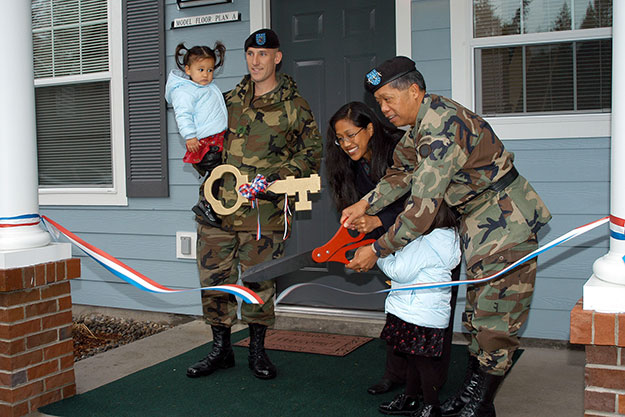(Photo: Retired Lt. Gen. Edward Soriano, then I Corps commanding general, along with an Army family, cut the ceremonial ribbon to dedicate the new 108-unit Beachwood II housing area on Lewis North, built under the Residential Communities Initiative in 2002.)
Over the past six months, Joint Base Lewis-McChord's privatized housing partner Lincoln Military Housing and base leaders have worked to fix reported deficiencies in on-base privatized housing. People and policies are also being put in place to ensure our on-base community receives the best quality housing available.
Recently, some residents asked why the military switched to privatized housing in the first place.
"The simple answer is, the Army was not resourced sufficiently, so we were unable to do housing well," said Steve Perrenot, JBLM Directorate of Public Works director.
 In 1998, the Army began looking for a way to interest developers in the construction and operation of installation family housing.
In 1998, the Army began looking for a way to interest developers in the construction and operation of installation family housing.
According to a housing study published in 2003 by the Naval Postgraduate School, many housing units on installations (in the 1990s) needed extensive renovation or replacement, but this was an era of declining budgets for military construction.
One proposal to improve military family housing was called the Residential Communities Initiative (RCI). The objectives of RCI were to create quality residential communities, and leverage assets and scarce funds as well as obtain private sector expertise, creativity, innovation and capital.
Under RCI -- today simply referred to as privatized military housing -- long-term business relationships are established with private sector developers to improve military family housing communities.
In August 2000, Army leaders implemented several RCI pilot programs to include Fort Lewis, now JBLM. In April 2002, all housing on JBLM was transferred to Equity Residential/Lincoln Fort Lewis Communities.
Immediately, 528 homes in the Old Hillside housing area on Lewis Main were mothballed and identified for later demolition. This is now the site of Discovery Village, the second RCI project on JBLM that involved 100 percent replacement of all housing in a previously existing neighborhood.
The first new homes built on JBLM under RCI were 108 units in the Lewis North Beachwood II housing area. Ground was broken May 17, 2002, and Beachwood II was dedicated Nov. 22, 2002. These homes were built for E4s through E6s.
"In the first four years of RCI, there were more new homes built on JBLM than the Army built here in the past 40 years," Perrenot said.
When Fort Lewis and McChord Air Force Base merged in 2010 to become JBLM, the housing on McChord Field became a part of the base RCI program.
The most recent RCI construction on base includes 156 units in the Stony Oak housing area on McChord Field, completed in 2016; 266 units in Meriwether Landing on Lewis North, completed in 2013; and the 220-unit Town Center on Lewis Main, JBLM's first nonsmoking community.
To date, JBLM's privatized housing partners Equity Residential Properties (2002-15) and Lincoln Military Housing (2016-present) have renovated 3,379 existing homes, designed and built 1,468 new homes, demolished 924 units, and built five community centers for military families to use for special events at a cost of $350 million. Currently, there are 5,159 family housing units in 22 communities on JBLM.
Moving forward, 80 new housing units are being constructed in the Meriwether Landing housing area on Lewis North at a cost of $33 million, and 167 housing units in the Heartwood III housing area on McChord Field are being renovated at a cost of $13 million. Construction and renovation will be done by 2022.
"Transferring the management of on-base housing to a privatized housing partner almost 20 years ago has served JBLM well," said Nancy Barnes, JBLM DPW/Residential Communities Initiative chief. "Privatized housing has done more for military families than our previous traditional housing approach could have ever accomplished."





Read Comments